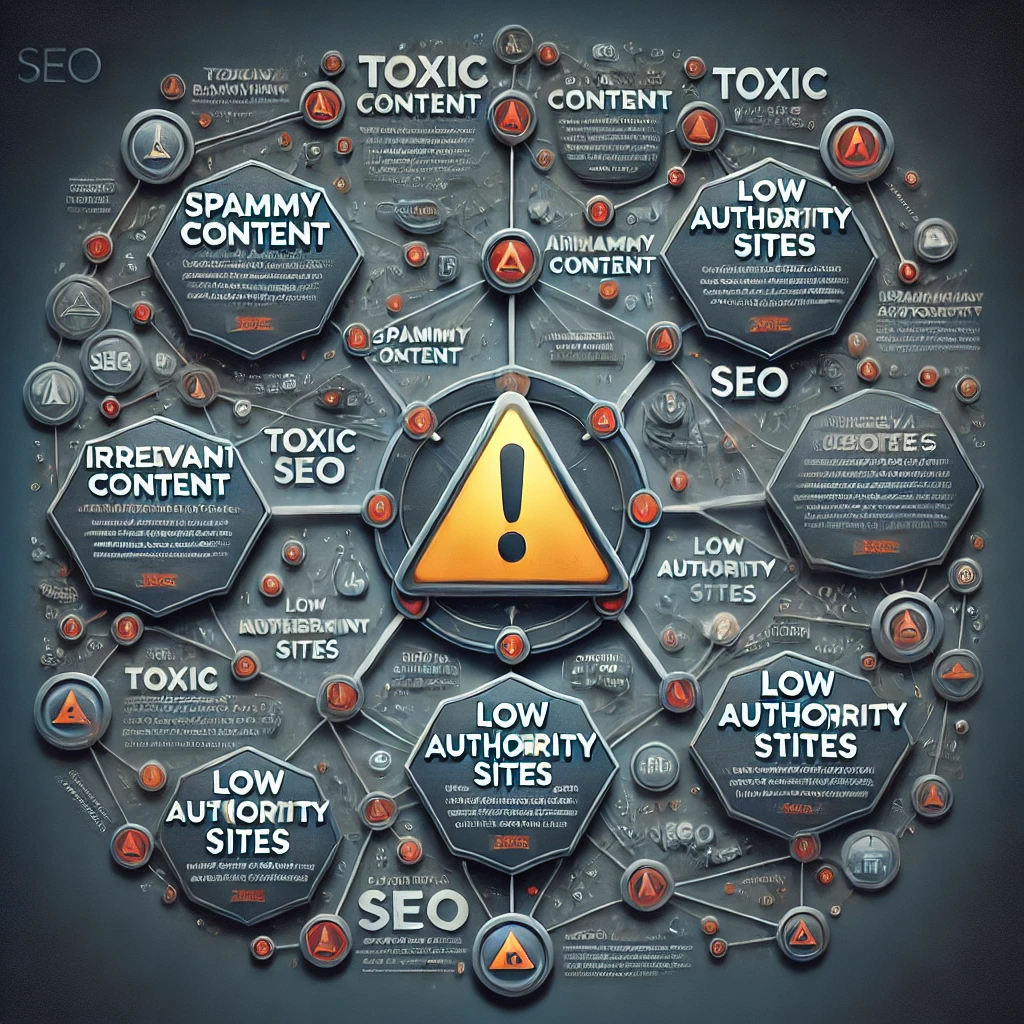Backlinks are a cornerstone of any successful SEO strategy. However, not all links are beneficial. Some, known as toxic links, can cause significant harm to your website’s search engine rankings. Understanding toxic links and their consequences is crucial for maintaining a strong online presence. In this article, we’ll explore what toxic links are, how they impact your site, and steps you can take to address them.
What Are Toxic Links?
Toxic links are backlinks from poor-quality, untrusted, or irrelevant sources that harm your website’s SEO health. These links violate search engine guidelines and often signal manipulative practices like link farming, paid links, or excessive link exchanges. Common sources of toxic links include spammy websites, private blog networks (PBNs), sites with malware, and those unrelated to your niche. For example, if your website is about technology, a backlink from a low-authority gambling site is considered toxic.
Search engines like Google prioritize quality over quantity when it comes to backlinks. Toxic links indicate that your website is engaging in practices that aim to game the system. This could lead to penalties, lower search rankings, or even removal from search results. Identifying and addressing toxic links is crucial for protecting your website’s SEO performance and ensuring that it meets search engine guidelines.
How Toxic Links Harm Your Website
The presence of toxic links can have several negative consequences for your website’s performance and reputation.
- Lower Search Rankings: Search engines aim to provide users with the most relevant and trustworthy results. Toxic backlinks can signal that your site is associated with low-quality or spammy content, causing your rankings to drop.
- Google Penalties: Google’s Penguin algorithm actively targets websites that engage in manipulative link-building tactics. If your backlink profile is flagged, you may face penalties ranging from ranking suppression to complete de-indexing.
- Damaged Credibility: Toxic links don’t just harm your relationship with search engines; they also affect how users perceive your site. If visitors find that your site is linked to irrelevant or suspicious sources, it can erode trust and damage your brand reputation. Ignoring toxic links can lead to long-term damage that’s difficult to recover from. Addressing them promptly is key to safeguarding your SEO efforts and maintaining a credible online presence.

How to Identify Toxic Links
Identifying toxic links is critical to maintaining a healthy backlink profile and protecting your website from SEO penalties. The first step is to use tools like Ahrefs, SEMrush, or Google Search Console to analyze your backlinks. These tools provide valuable metrics such as domain authority, spam scores, and link relevance, helping you spot harmful links quickly. Pay attention to red flags like backlinks from low-authority domains, spammy websites, or irrelevant industries. For example, if your website is about fitness and receives a backlink from a gambling or adult content site, it’s likely toxic. Similarly, links with over-optimized anchor text (e.g., exact-match keywords repeated excessively) can also harm your SEO. Context is equally important—review where the link is placed on the referring site. Toxic links often come from pages with an excessive number of outbound links or irrelevant, low-quality content. Additionally, backlinks from foreign-language sites unrelated to your niche should raise concern.
By regularly auditing your backlink profile and addressing toxic links early, you can prevent them from damaging your website’s search rankings and credibility.
How to Remove or Disavow Toxic Links
Removing toxic links from your backlink profile requires a strategic approach. Here’s how to do it:
- Contact Website Owners: Start by reaching out to the webmasters of sites hosting harmful links. Politely request that they remove the backlink. Include specific details like the URL and location of the link for clarity. While not all requests will be successful, this step shows Google that you’re taking action.
- Use Google’s Disavow Tool: For links that cannot be removed, use Google’s Disavow Tool to inform the search engine that you don’t want those links to be considered. This tool allows you to submit a file listing all harmful links, helping protect your site from penalties.
- Perform Regular Audits: Regularly analyze your backlink profile to catch toxic links early. Incorporating this practice ensures your website stays in compliance with search engine guidelines.
- Monitor New Backlinks Regularly: Continuously track your backlink profile to identify and address harmful links as they appear. Tools like Ahrefs, SEMrush, or Moz can help you monitor new backlinks and assess their quality to prevent future issues.
- Create High-Quality Backlinks: Counterbalance toxic links by building high-quality backlinks from reputable sites. Engage in content marketing, guest posting, or collaborations with authoritative websites to strengthen your backlink profile and improve your SEO ranking.

Best Practices to Avoid Toxic Links
Avoiding toxic links is critical to maintaining a healthy backlink profile and safeguarding your website’s SEO performance. One of the best practices is to focus on earning links naturally through high-quality, relevant, and engaging content. When your content provides genuine value, authoritative websites are more likely to link to it organically. Another essential practice is to vet potential link-building opportunities thoroughly. Avoid engaging with low-quality or irrelevant websites, link farms, or directories that are notorious for hosting spammy links. Instead, prioritize collaborations with reputable sites that have strong domain authority and align with your industry niche. Consistently monitoring your backlink profile with tools like Google Search Console, SEMrush, or Ahrefs is also vital. These tools allow you to identify and disavow harmful links proactively. Additionally, diversifying your backlink sources is crucial to avoid reliance on any single domain, which can increase vulnerability to toxic links. Regular audits and updates to your link-building strategy, coupled with staying informed about Google’s guidelines and algorithm updates, can help you steer clear of practices that may inadvertently attract toxic backlinks. By adhering to these best practices, you can build a robust and sustainable SEO strategy.
Conclusion
Toxic links are a hidden threat that can severely impact your website’s SEO success. Understanding their sources, identifying harmful backlinks, and taking steps to address them is essential for protecting your site’s rankings and reputation. Regular backlink audits, disavowing toxic links, and prioritizing high-quality content are key practices for maintaining a healthy online presence. By staying vigilant, you can safeguard your website against penalties and ensure long-term success in search rankings. Investing in ethical link-building strategies and proactive management will position your site as a trusted and credible resource in your niche.
What should I do if my website has toxic links?
Start by contacting the webmasters of the sites hosting these links and requesting their removal. If unsuccessful, use Google’s Disavow Tool to tell search engines to ignore those links.
How often should I audit my backlink profile?
It’s recommended to audit your backlink profile at least quarterly. Regular audits ensure you catch toxic links early and maintain a clean, SEO-friendly link profile.
Can toxic links get my website penalized by Google?
Yes, toxic links can lead to penalties, especially under Google’s Penguin algorithm. These penalties can lower your rankings or result in your site being de-indexed from search results.
How can I prevent toxic links in the future?
Focus on building high-quality, organic backlinks from reputable sources. Avoid link-buying schemes and regularly monitor your backlink profile for any harmful links.
Are all low-quality links considered toxic?
Not necessarily. While low-quality links might not benefit your SEO, they become toxic if they violate search engine guidelines or come from spammy, irrelevant sources.
Can toxic links be deleted?
While you can often remove toxic links by contacting webmasters, some may not respond. For such cases, using Google’s Disavow Tool is the best way to mitigate the impact.



